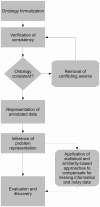PhenomeNET: a whole-phenome approach to disease gene discovery
- PMID: 21737429
- PMCID: PMC3185433
- DOI: 10.1093/nar/gkr538
PhenomeNET: a whole-phenome approach to disease gene discovery
Abstract
Phenotypes are investigated in model organisms to understand and reveal the molecular mechanisms underlying disease. Phenotype ontologies were developed to capture and compare phenotypes within the context of a single species. Recently, these ontologies were augmented with formal class definitions that may be utilized to integrate phenotypic data and enable the direct comparison of phenotypes between different species. We have developed a method to transform phenotype ontologies into a formal representation, combine phenotype ontologies with anatomy ontologies, and apply a measure of semantic similarity to construct the PhenomeNET cross-species phenotype network. We demonstrate that PhenomeNET can identify orthologous genes, genes involved in the same pathway and gene-disease associations through the comparison of mutant phenotypes. We provide evidence that the Adam19 and Fgf15 genes in mice are involved in the tetralogy of Fallot, and, using zebrafish phenotypes, propose the hypothesis that the mammalian homologs of Cx36.7 and Nkx2.5 lie in a pathway controlling cardiac morphogenesis and electrical conductivity which, when defective, cause the tetralogy of Fallot phenotype. Our method implements a whole-phenome approach toward disease gene discovery and can be applied to prioritize genes for rare and orphan diseases for which the molecular basis is unknown.
Figures



References
-
- Rosenthal N, Brown S. The mouse ascending: perspectives for human-disease models. Nat. Cell. Biol. 2007;9:993–999. - PubMed
-
- Abbott A. Mouse megascience. Nature. 2010;465:526. - PubMed
-
- Collins FS, Finnell RH, Rossant J, Wurst W. A new partner for the international knockout mouse consortium. Cell. 2007;129:235. - PubMed

